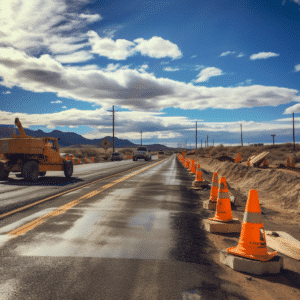
When it comes to avoiding rollover accidents, knowing “what two things are important to prevent rollover” can be a life-saver. Vehicle stability and speed control stand out as the pillars of prevention. Dive into our guide to understand and apply these essential strategies for a more secure driving experience.
Key Takeaways
- Rollover accidents, while relatively rare, constitute a significant proportion of highway fatalities and can be primarily attributed to a vehicle’s design dynamics, road conditions, or improper handling during maneuvers.
- Preventing rollover accidents involves improving vehicle stability by optimizing design features and securing loads, and speed control through cautious driving adjusted to road design and conditions.
- Robust infrastructure design, including safer roads and intersections, along with legal frameworks for liability and compensation, also play critical roles in mitigating rollover risks and addressing their consequences.
Contact us today and we will help you get the compensation that you deserve.
Understanding Rollover Accidents
Rollover accidents, though accounting for a small percentage of all crashes, are a significant contributor to highway fatalities. These are incidents where a vehicle rotates 90° or more about any longitudinal or lateral axis. They’re not just frightening; they’re also deadly and come with substantial economic implications.
Causes of Rollover Accidents
So, what causes these devastating accidents? A multitude of factors can contribute. For one, a vehicle’s design and dynamics play a pivotal role. Vehicles, especially those with a higher center of gravity such as SUVs, pickup trucks, and vans, are more susceptible to rollovers during sharp turns or sudden maneuvers.
Another major contributing factor is road conditions. For instance, rural roads with speed limits of 55 mph or higher, which are often undivided highways without barriers, account for approximately 75% of fatal rollovers.
Consequences of Rollover Accidents
The consequences of these accidents are severe. Rollover crashes account for nearly one-third of all occupant deaths on highways, resulting in a significant toll on human life. Moreover, the economic burden of such accidents is considerable, representing about 33% of annual injury costs in the US, which equates to approximately $40 billion.
The injuries associated with rollovers are often severe, with head and neck injuries making up 50% and spinal injuries accounting for another 10% of the harm caused. The risk multiplies in cases where occupants are ejected, and the vehicle’s roof integrity is compromised.
Key Factors in Preventing Rollover Accidents
While the statistics are shocking, one should realize that rollover accidents involving motor vehicles are largely preventable. Vehicle stability and speed control are two key factors that can help prevent these accidents.
Vehicle stability refers to how well a vehicle resists rollover tendencies during cornering, evasive maneuvers, and high wind conditions. On the other hand, speed control demands maintaining a safe speed adjusted to road conditions and vehicle load.
Vehicle Stability
Enhancing vehicle stability can be achieved by optimizing design characteristics of a vehicle, such as a low center of gravity and a wide track. For instance, choosing a lower vehicle and avoiding added high-mounted weight, like not opting for a sunroof, can lower a vehicle’s center of gravity and thereby improve stability.
Securing cargo properly, especially in the case of liquid cargo tanks, is another important aspect to prevent load shift that can lead to rollovers.
The role of technology, like electronic stability control systems, is also noteworthy in enhancing vehicle stability.
Speed Control
Despite the significant roles of technological enhancements and vehicle design, the driver has a substantial part to play in rollover prevention. Speed control is one such area where the driver has a direct impact on preventing rollovers. It is particularly important to maintain lower speeds when navigating corners to keep the vehicle’s center of gravity stable. Furthermore, adjusting speed gradually in response to road hazards and conditions can prevent the imbalance that may lead to a vehicle rolling over.
In adverse weather conditions, driving at a speed safe for the conditions is crucial to reduce the likelihood of a rollover; slowing down is often necessary to maintain control. Moreover, maintaining a safe following distance gives the driver ample time to react to roadway developments without resorting to abrupt maneuvers that could cause a rollover.
Safe Driving Practices to Avoid Rollovers
The driver’s actions and decisions have a significant influence on the likelihood of a rollover. Therefore, it is imperative for an experienced driver to adopt safe driving practices. Reducing the likelihood of rollover accidents requires drivers to adapt their driving to the demands of the situation.
Avoiding sudden movements like swerving can prevent rollovers, especially when reacting to sudden lane changes or incorrect signaling by others. Furthermore, when driving at night or encountering curves, reducing speed before entering the curve and maintaining focus can help avoid rollovers.
Defensive Driving Techniques
Preventing rollovers can be effectively achieved through defensive driving techniques. For instance, the Smith5Keys principles, such as aiming high in steering and keeping eyes moving, help drivers anticipate and prepare for potential road hazards, thereby aiding in rollover prevention.
A proper following distance and clear visibility aids in foreseeing potential hazards, allowing for timely reactions and prevention of rollover incidents. In addition, avoiding sharp turns or overcorrection, which can lead to a pendulum effect, is crucial for better stability control.
Navigating Challenging Road Conditions

In adverse weather conditions like fog, using appropriate lighting is key to maintaining clear vision and preventing rollovers. Similarly, during rain, maintaining a significant distance from other vehicles and using middle lanes can prevent hydroplaning and rollovers. In snowy or icy conditions, taking corners slowly, accelerating gradually, and watching for black ice can help maintain control and avoid rollovers.
Furthermore, ensuring that windshield wipers are in good condition and replacing them when dull can maintain visibility and reduce the risk of rollovers in unexpected storms. Moreover, making gradual changes in speed and position can help regain control when a driver has lost it due to challenging road conditions.
Proper Vehicle Maintenance
Another necessary aspect of preventing rollovers is proper vehicle maintenance. Ensuring regular tire maintenance, including checking tire inflation pressure, is crucial to prevent instability on the road caused by underinflated or overinflated tires.
Ensuring that brakes are in optimal working condition is vital, as evidenced by a study that showed 54% of vehicles involved in rollover accidents had a brake defect. Regular inspections are necessary to identify and address wear and possible defects in vehicle components, including brake pads and fluids, to prevent mechanical failure that could result in rollovers.
Timely repairs and replacements as part of routine vehicle maintenance can significantly improve a vehicle’s performance and safety, thereby reducing the likelihood of rollover accidents.
The Role of Infrastructure in Rollover Prevention
Infrastructure, along with the driver’s actions and vehicle stability, has a role in preventing rollovers. Poor road design, such as sharp curves without appropriate signage, uneven road surfaces, and inadequate road camber, can all create hazardous conditions that contribute to the dynamic forces causing vehicle rollovers.
Factors like lateral forces experienced during a turn can shift a vehicle’s center of gravity and affect balance, increasing rollover risk, particularly when road design does not account for vehicle dynamics. Areas like:
- Exit ramps
- Curves
- Intersections
- Steep declines
Rollover accidents are common at sites with challenging terrain, as the challenge for vehicles is to adjust speed or direction suddenly.
Interstate Highways and One-Way Streets
Designing roads to enhance traffic flow and safety can play a significant role in preventing rollovers. For instance, one-way streets are especially beneficial in downtown or congested places as they enhance traffic flow and allow for more effective signal timing.
Moreover, the design of one-way streets has several benefits, including:
- Reducing the number of directions pedestrians need to watch for oncoming traffic, which can lead to a decrease in pedestrian-involved accidents
- Enhancing the smooth flow of vehicles
- Significantly reducing the chances of rollover accidents
Careful road design, in accordance with the federal highway administration guidelines, can have a positive impact on both vehicle and pedestrian safety, benefiting motorists as well.
Improving Intersections and Visibility
Improving intersections and visibility is another vital aspect of rollover prevention. Intersection safety can be enhanced by modifications to traffic signals, striping, and signage to enhance visibility for all road users.
The design of one-way streets should include considerations of traffic circulation to prevent confusion and ensure clear visibility, which is critical to road safety. Additionally, special design considerations are required for roundabouts to prevent rollovers, especially to accommodate the safe navigation of long high-sided vehicles.
Legal Considerations and Compensation
When a rollover accident occurs, legal considerations and compensation become important. Determining liability is crucial, and it impacts the compensation mechanisms, which can include workers’ compensation claims and personal injury lawsuits.
Workers’ compensation is a no-fault system that provides benefits to injured employees regardless of who caused the rollover accident, covering medical bills and lost wages. On the other hand, personal injury lawsuits for rollover accidents require proving negligence or wrongdoing to obtain compensation for medical expenses, wage replacement, and potentially additional damages such as pain and suffering.
Determining Fault in Rollover Accidents

- a trucking company’s negligence contributed to the accident
- a defective vehicle component caused the rollover
- another driver’s actions led to the accident.
Determining fault often requires an investigation into the cause, such as:
- improper cargo distribution
- driver fatigue
- mechanical issues
- other contributing factors
Police reports and witness statements provide critical insights into establishing fault, with law enforcement detailing findings and witnesses offering objective accounts of the events.
Seeking Compensation for Injuries and Damages
Once fault is determined, the next step is to seek compensation for injuries and damages. Consulting with an attorney specializing in personal injury is a critical step for pursuing a lawsuit after a rollover accident.
The decision to file for workers’ compensation or pursue a personal injury lawsuit after a rollover accident hinges on the specifics of the case and the injured individual’s employment status. Understanding the legal implications and rights is crucial for making an informed decision about seeking compensation.
Frequently Asked Questions
What two things are important to prevent a rollover CDL?
To prevent a rollover CDL, it’s important to keep the cargo close to the ground and drive slowly around turns. This helps minimize the risk of rollovers by maintaining stability and control over the vehicle.
What trailer is most likely to turn over?
The last trailer in a combination is most likely to turn over due to the “crack-the-whip” effect caused by sudden turns when pulling doubles or triples. It is important to steer gently when pulling trailers to avoid this risk.
Which vehicle will be more prone to rollover quizlet?
Vehicles with a high center of gravity, such as SUVs, are more prone to rollovers. This is due to their stability being compromised by the higher center of gravity.
Is roadway design the cause of a collision?
Yes, roadway design can play a significant role in causing car accidents, although accident victims may not always be aware of this factor.
How can vehicle stability be improved to prevent rollover accidents?
To prevent rollover accidents, it’s important to lower the vehicle’s center of gravity, avoid adding high-mounted weight, and ensure proper securing of cargo, particularly in liquid cargo tanks. These measures can significantly improve vehicle stability and safety on the road.
Last updated Thursday, June 20th, 2024 | Written by Puneet Garg






